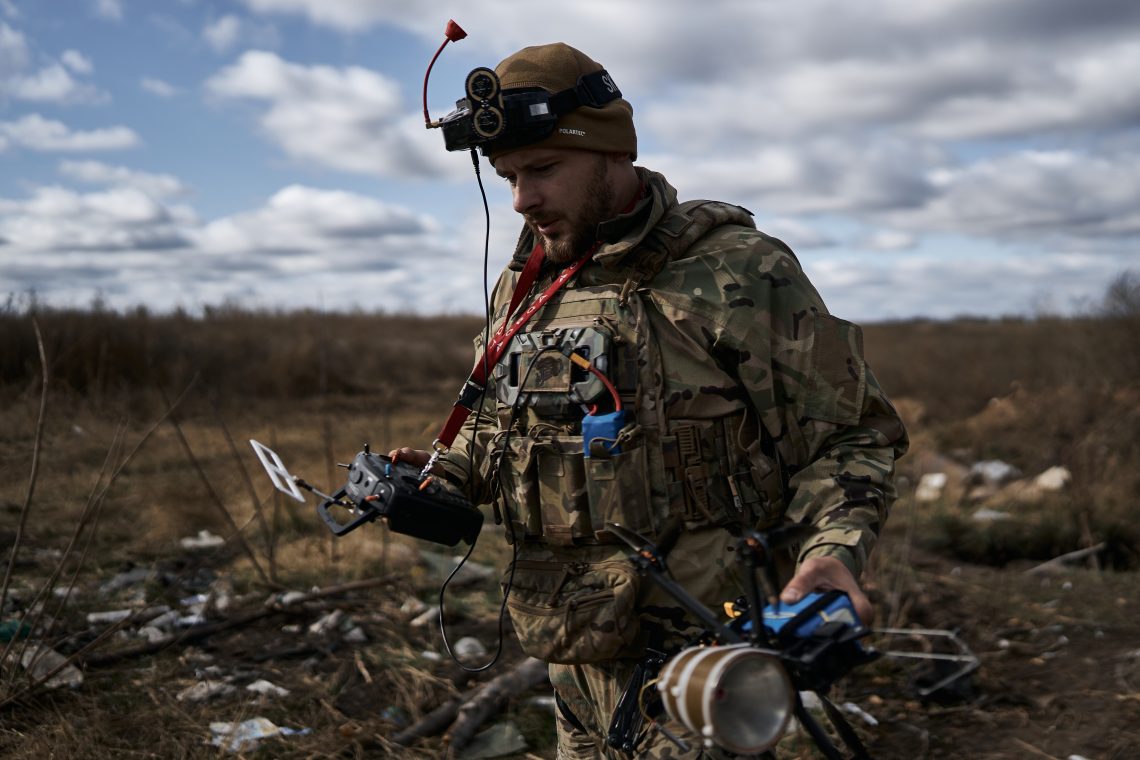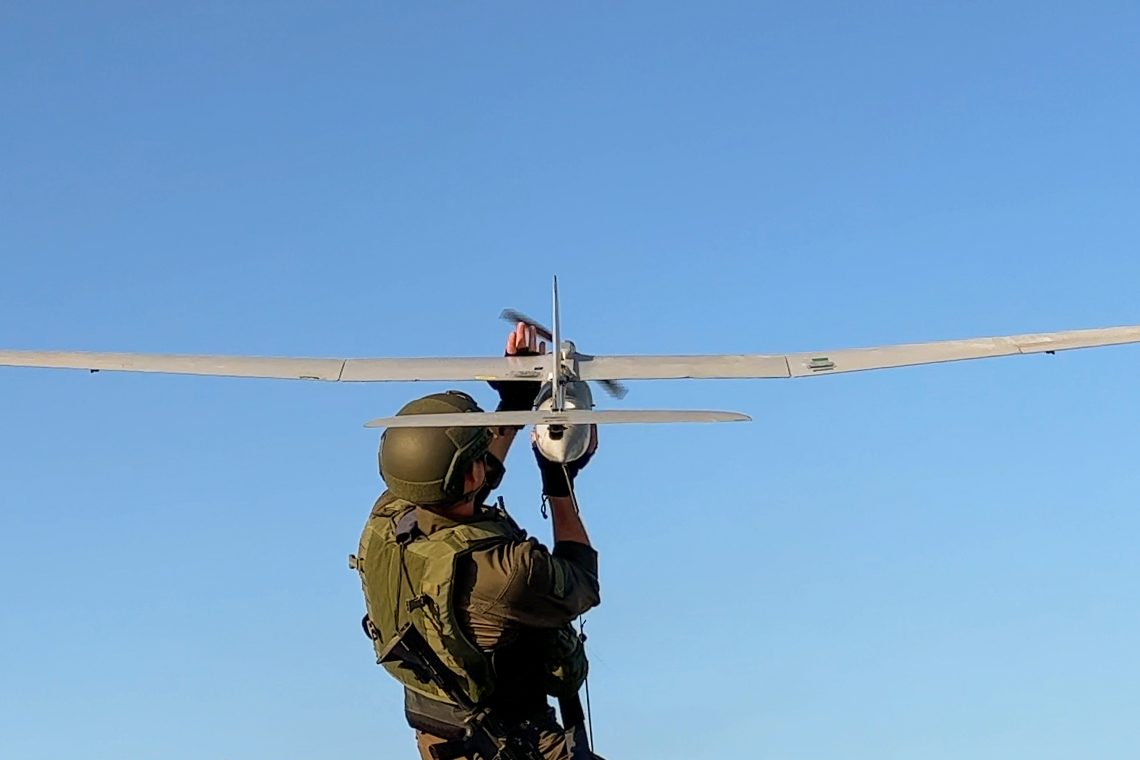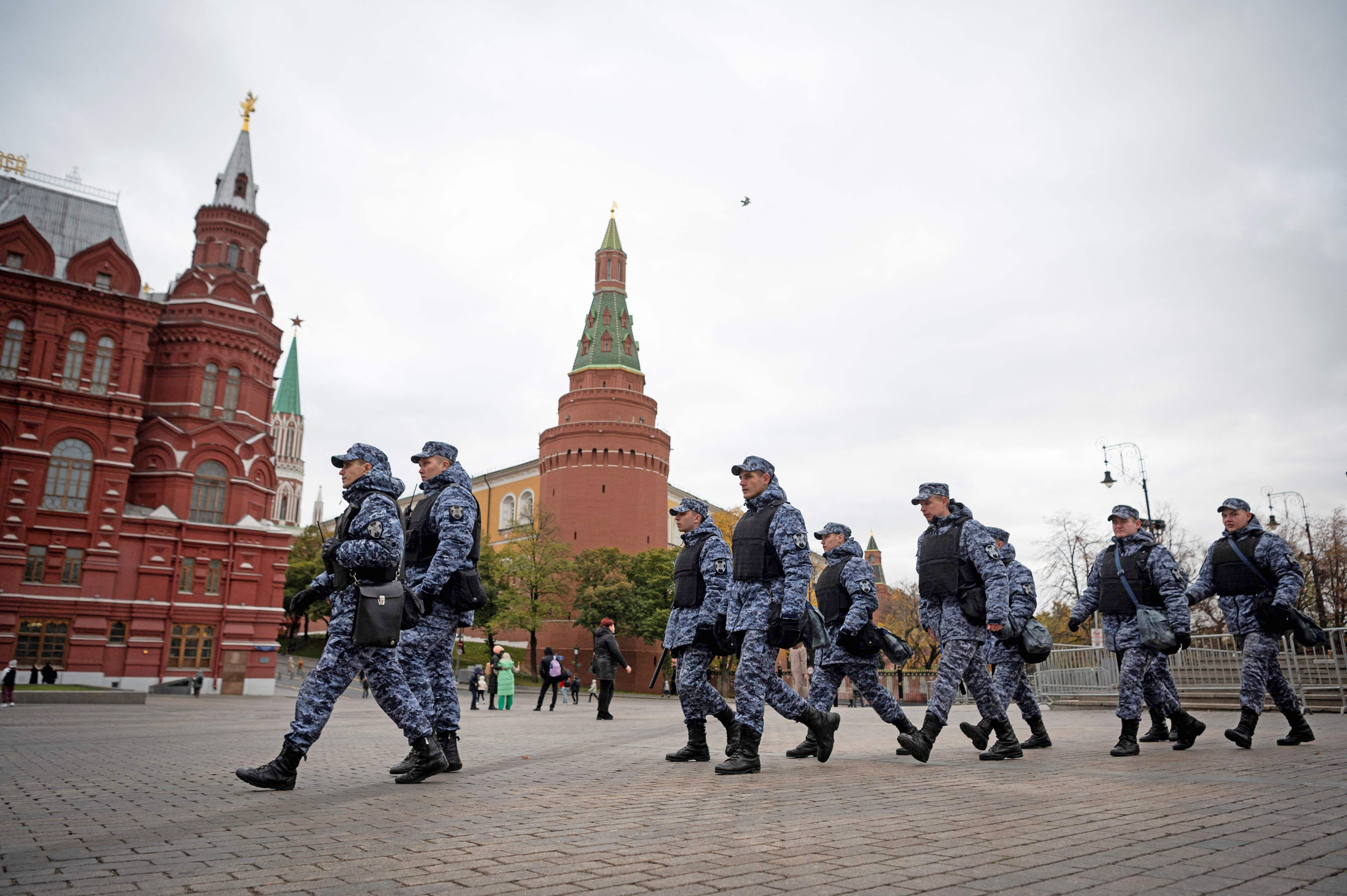Attack drones are transforming modern battlefield operations, with today’s conflicts serving as laboratories for rapid innovation.
 A Ukrainian military drone pilot attaches an explosive to an FPV drone at the front line near Bakhmut, Ukraine, on October 24, 2023. © Getty Images
A Ukrainian military drone pilot attaches an explosive to an FPV drone at the front line near Bakhmut, Ukraine, on October 24, 2023. © Getty Images
- First-person view drones unlock new offensive capabilities
- Ukrainian and Israeli forces have been pioneers in their use
- Countermeasures will likely catch up, mitigate the long-term impact
In the rapidly evolving military technology landscape, unmanned aerial vehicles (UAVs) have emerged as the most salient in a long list of disruptive technologies. Drones have altered the face of modern battlefield operations far beyond the generally assumed advances – including in some of today’s most active conflicts. Today’s UAVs offer not only enhanced surveillance and reconnaissance but also tactical offensive capabilities.
Among the myriad types available, first-person view (FPV) drones stand at the cutting edge, giving operators real-time situational awareness and the ability to precisely destroy targets of opportunity. Most importantly, FPV drones offer stand-off precision weaponry at a fraction of the cost compared to conventional complex precision munitions, and with minimal training. In the words of frontline operators this author has worked with, they are effectively “cruise missiles in a backpack.”
This unanticipated reconfiguration of civilian grade, commercial-off-the-shelf (COTS) technology is having a growing effect on battlefield operations in contemporary Ukraine and Israel/Gaza, blurring the distinction of what makes for a technically superior adversary. FPV drones are the quintessential asymmetric weapon – the latest round in a rapid arms race pitting cheap, amateur-deployed weapons against expensive, highly technical legacy systems. Used properly, attack drones can act like David’s sling against Goliath’s sword.
Crucially, however, while drones are here to stay, these weapons are unlikely to continue to dominate battlefield operations, as the countermeasures eventually catch up to their asymmetric advantages.
FPV drones have gained prominence for providing operators with a live video feed, allowing them to navigate and control the device as if they were physically on board. This immersive experience enhances the operator’s situational awareness and ability to react, making them invaluable for defense purposes.
The roots of FPV technology can be traced to the early days of radio-controlled model aircraft. However, it was the integration of compact cameras and real-time video transmission capabilities that propelled these drones into the mainstream. As technology iterated, they evolved from hobbyist gadgets (often used in drone racing) to sophisticated tools with military-grade applications.
The key characteristics of FPV drones are: 1) real-time video transmission, allowing operators to make immediate decisions on the fly; 2) immersive, first-person control, enabling more precise and responsive maneuvers; and 3) their compact size and maneuverability, making them suitable for diverse environments.
These qualities are especially valuable in a military context, and it was only a matter of time before these nominally “commercial” tools were refitted to a combat role.
This report is an assessment of FPV drone deployment in parallel theaters of operations: the Ukrainian eastern front against Russia and the Israeli fronts against Hamas in the Gaza Strip and Hezbollah along the Lebanese border.
While both sides in each theater use FPV drones, in Ukraine it is the “underdog” (Ukrainian forces) that currently has a marginal edge in the development and deployment of attack drones. In Israel, however, the nominally superior force (the Israel Defense Forces) also maintains an advantage in attack drones. This probably reflects the creative technical advantages that accrue to relatively free societies compared to authoritarian ones. Hackers and tinkerers appear somewhat slower to innovate under the heavy hands of both Russian and Hamas authorities.
That said, the advantages to Ukrainian or Israeli forces are anything but guaranteed. In Ukraine, it is said that Russia is a slow learner, but when it learns, it does so at scale. As Russian forces outproduce Ukrainians in building and deploying drones (even while remaining slower to innovate), asymmetries may appear on both sides of the Surovikin Line. In Israel, too, Hamas for similar reasons may find it most efficient to allocate more of its dwindling resources toward the asymmetries of drones as one of the only viable ways to make progress.
While more countries invest in FPV drone technology, predictions of seismic shifts in military capabilities are likely exaggerated.
In Ukraine, the first hints of weaponized civilian drone technologies were observed with crude camera drones used to drop grenades. Since then, the pace of military-hacked COTS drones has escalated rapidly. Ukrainian forces now utilize FPV drones to conduct tactical surveillance and reconnaissance, gaining critical intelligence on enemy movements and positions as well as directly attacking targets. The ability to deploy these devices in contested areas while minimizing risks to human life significantly enhances both tactical and strategic decision-making.
Moreover, Ukraine has had growing success in attacking distant targets such as the attack on Tu-22 bombers at Soltsy-2 Airbase in August or numerous assaults on the Kerch Bridge in Crimea. More recent attacks on fuel and ammunition depots in Luhansk have forced Russia to reposition its resources at considerable expense. Russian audio feeds of such attacks demonstrate that the reflexive response to drone attacks is to “scatter,” dispersing manpower and equipment to reduce their targetable signature. Drone strikes thereby not only impact their immediate target but disrupt the larger operational ecosystem of the targeted force.
Currently, according to frontline operators on the Donetsk front, the most common countermeasures against FPV drones are jammer units (known as “domes”) placed atop armored vehicles, as well as backpack-carried omnidirectional jammers for infantry. A primary limitation of these jammers is that they need sufficient power in a certain frequency sector, which constrains their operations to a narrow set of the most popular frequency ranges.
Eyewitness to war: Assessing Ukraine’s counteroffensive
According to one fighter: “A logical response from drone manufacturers is to introduce new control frequencies that are not yet covered by jammers or GPS spoofers. This constant catch-up game in technology development will sooner or later lead to all frequencies being suppressed in the combat contact zone, from kilohertz to satellite communication.”
Russian forces are adapting to this eventuality, with field intelligence reporting they are “using partially autonomous FPV drones, which are guided by an operator until the loss of communication, and then automatically select a target based on image recognition technologies through their own camera.” Moreover, according to my source, “the cost ratio of [anti-drone] missiles to cheap long-range drones, such as the Iranian Shaheds, is strategically advantageous for the attacking side in a long-term game, and Russia seems willing to wait. Therefore, it is necessary to develop counter-drone measures based on new physical principles; for example, using directed electromagnetic pulses when deploying air defense at power stations where there are sufficiently powerful energy sources.”
Israel has long been recognized as a pioneer in military technology, with a robust defense industry that continually pushes the boundaries of technical innovation. In the realm of FPV drones, Israel has made significant strides, developing cutting-edge technologies that enhance surveillance and offensive capabilities (such as the ability to fire 40mm grenades). Meanwhile, Hamas (and to a lesser extent Hezbollah) militants are in a much better position to take advantage of the asymmetries of attack drones. While they have yet to fully adopt these FPV technologies, the outsize benefits against a large, mechanized adversary like the IDF are simply too large to ignore indefinitely.
FPV use by the IDF is more common in the northern front against Hezbollah than its operations in the Gaza Strip against Hamas. This is due in part to existing IDF air superiority, with fighters reporting they “can call in a two-thousand-pound JDAM [Joint Direct Attack Munition] and take out a whole building” rather than rely on attack drones. In Gaza operations, especially, the frequency environment is so swamped with jamming and GPS spoofing transmissions that operators say civilian-grade FPV signals are “lost in the sauce,” making it difficult to deploy friendly FPV units.
 An Israel Defense Forces reservist from the “Sky Rider” unit launches a surveillance drone known as the Skylark, for an operation near the Gaza border on December 11, 2023, in southern Israel. © Getty Images
An Israel Defense Forces reservist from the “Sky Rider” unit launches a surveillance drone known as the Skylark, for an operation near the Gaza border on December 11, 2023, in southern Israel. © Getty Images
Advances are being made by both sides to avoid drone dependence on civilian signals/navigation aids. For instance, since most GPS signals in Gaza are spoofed to force drones to self-locate to alternate locations, adaptations of radio-frequency high-gain antennas are used to allow COTS drones to bypass this inherent weak link. The use of drones by Hezbollah, seen in the first moments of Hamas’s October 7 attack on Israel, appears so far to be essentially dependent on GPS. They also increasingly employ a “mini-Shahed,” kamikaze-type drone with a range of 10-20 kilometers.
Techniques for pinpointing and eliminating adversary drone operators have become a major focus, and all sides are investing heavily in sophisticated detection equipment and strategies. Nevertheless, in both theaters, the limiting factor for successful FPV deployment is less technical capacity than access to training. As an operator embedded within the IDF has noted, the successful use of attack drones is technically “pretty simple,” but there is a basic “knowledge issue” at play: combatants with real-life experience, especially experience gained from operations in Ukraine, are at a premium because they “just know what they’re doing.” Simple tricks, techniques and hacks (such as fusing explosives with caps) can be of extraordinary value.
The deployment of FPV drones by Ukrainian and Israeli forces underscores their transformative impact on modern warfare. As nations leverage the advantages of real-time situational awareness, enhanced reconnaissance capabilities and surgical munitions delivery, the geopolitical landscape evolves accordingly. The use of FPV attack drones on the Ukrainian and Israeli fronts has had ripple effects, influencing the geostrategic balance of power in complicated and often counterintuitive ways.
Nevertheless, while more countries invest in and deploy FPV drone technology, predictions of seismic shifts in military capabilities and alliances are likely exaggerated. Yes, the rapid evolution of FPV drones contributes to an arms race, with adversaries seeking to outpace each other in developing ever-more-advanced systems. Yet this contest of measure/countermeasure is likely to reach a kind of equilibrium in relatively short order (one to three years). The proliferation of FPV drones raises legitimate concerns about their use in future conflicts and consequences for global security, but their current reputation as a fundamental disruptive technology is probably overblown.
It is unlikely that attack drones will continue their meteoric dominance of the battlespace for the long term. Such a scenario would see advances in capability continue apace, particularly in integrating artificial intelligence – and to do so faster than innovations in drone interdiction countermeasures. This scenario is not to be discounted – and is clearly critical in the short term (one year) – but is unlikely to define the long-term outlines of conflict.
As drone technologies develop, we will most likely witness an escalating arms race toward increasingly smaller, more surgical weapons coupled with more adept countermeasures to defeat them. Defenders learn quickly, and a new technical detente will emerge that reaffirms the basic advantages of advanced economies’ military hardware investments.
As the recent Houthi drone attacks in the Red Sea demonstrate, drone countermeasures to protect expensive military hardware – developed and deployed years or decades earlier – will be paramount. Drones therefore represent a significant reallocation of resources but not a wholesale transformation of military strategy.
For industry-specific scenarios and bespoke geopolitical intelligence, contact us and we will provide you with more information about our advisory services.

Receive insights from our experts every week in your inbox.
